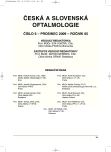Objective Assessment of the Central Visual Acuity by Means of the Visual Evoked Potentials
Authors:
L. Hejsek 1; H. Langrová 2; J. Pašta 1; P. Rozsíval 2
Authors‘ workplace:
Oční klinika 1. LF UK a ÚVN, Praha, přednosta plk. doc. MUDr. Jiří Pašta, CSc.
1; Oční klinika FN UK, Hradec Králové, přednosta prof. MUDr. Pavel Rozsíval, CSc.
2
Published in:
Čes. a slov. Oftal., 65, 2009, No. 6, p. 227-233
Category:
Overview Report
Overview
The authors refer about the possibility, method, testing and results of objective assessment of the central visual acuity in healthy and visually impaired volunteers. The principle of the method is (using visually evoked potentials – sweep VEP) extrapolation of the maximal perceived spatial frequency, or the minimal angle of separation, which represents the visual acuity. Altogether 73 persons (54 healthy and 19 objectively visually impaired) were examined, the visual acuity established using the ETDRS chart was compared to the acuity extrapolated from the sweep VEP. Results obtained by means of those two methods did not statistically significantly correlate.
Conclusion:
The objective testing of the visual acuity we do not recommend for routine use, the examination is at this time used for the purpose of estimation of the visual acuity and objectification of visual pathway functionality as a whole.
Key words:
visual acuity, evoked potentials, sweep VEP
Sources
1. Arai, M., Katsumi, O., Paranhos, F.: Comparison of Snellen acuity and objective assesment using the spatial frequency sweep PVER. Graefeęs Arch. Clin. Exp. Ophthalmol., 1997; 235: 42–447.
2. Bach, M. (2006) Homepage of the Freiburg Visual Acuity and Contrast Test (‘FrACT’). Retrieved 2006-07-04, from http://www.michaelbach.de/fract.html
3. Byron, L.: Electrophysiology if vision. 1. vyd. Tylor&Francis Group, Boca Raton, N.W., 2005, 514s.
4. Campbell, F., Maffei, L.: Electrophysiological evidence for the existence of orientation and size detectors in the human visual system. J. Physiol. (Lond), 1970; 222: 345–356.
5. Diener, H., Koch, W., Dichgans, J.: The significance of luminance on visual evoked potentials in diagnosis of MS. Arch Psychiatr Nevenkr, 1982; 231: 149–154.
6. Ferris, F., Kassof, F., Bresnick, G. et al.: New visual acuity charts for clinical research. Am J Ophthalmol., 1982; 94: 91-96.
7. Grussel, O., Grussel-Cornels, U.: Gesichtssinn und Okulomotorik. Schmidt FS & Thews G Physiologie des Menschen. Springer, Berlin, 1997; 278–315.
8. Hajek, A., Zrenner, E.: Verbesserte objective Visusprüfung mit visuell evozierten corticalen Potentialen durch schnelle Reizmustersequenzen unterschiedlicher Raumfrequenz. Fortschr. Ophthalmol., 1988; 85: 550–554.
9. Harter, M., White, C.: Effects on contour sharpness and check-size on visually evoked cortical potentials. Vision Res., 1968; 8: 701–711.
10. Heckenlively, R. et al.: Principles and Practice of Clinical electrophysiology of vision, 2. vyd., Mit Press, Massachusetts 2006, 977 s.
11. Hobley, A., Harding, G.: The topography of the P1 component of the flash visual evoked response. Doc Ophthalmol 1989; 73: 119–125.
12. Hubel, D, Diesel, T.: Functional architecture of macaque monkey visual cortex. Proc R Soc Lond B Biol Sci 1977; 198: 1–59.
13. Jindra, L.,F., Zemon, V.: Contrast sensitivity testing: A more complete assessment of vision. J Cataract Refract Surg, 15, 1989; 141–148.
14. Kraus, H. a kol.: Kompendium očního lékařství. 1. vyd. Grada, Praha 1997, 360 s.
15. Langrová, H., Jaegle, H., Messias, A. et al.: Visual acuity estimates from visual evoked potentials: A comparison of two methods, Poster 3314/A72, ARVO 2008.
16. Pastrňáková, I., Peregrin, J. a Svěrák, J.: Optické evokované potenciály a zraková ostrost, Čs. fyziol. 24, 1975; s. 447–449.
17. Peregrin, J.: Česká státní norma pro určování vízu, Čes. a Slov. Oftalm. 1999; 54: 48.
18. Regan, D., Silver, R., Murray, T., J.: Visual acuity and contrast sensitivity in multiple sclerosis – hidden visual loss. Brain, 100, 1977; 563–579.
19. Tootell, R., Hadjikhani, N., Vanduffel, W. et al.: Functional analysis of primary visual cortex (V1) in humans. Proc Natl Acad Sci USA 1998; 95: 811–817.
20. Tyler, C., Apkarian, P., Levi, D.: Rapid assessment of visual function: an electronic sweep psychophysical and evoked potential visual acuity determinations. AM J. Optom. Physiol. Opt. 1979; 62: 668–679.
21. Wolf, M.: Objektive Visusbestimmung mit Visuell Evozierten Petentialen, Dissertation zur Erlangung des Medizinischen Fakultät der Albert-Ludwigs-Universität Freiburg
Labels
OphthalmologyArticle was published in
Czech and Slovak Ophthalmology

2009 Issue 6
Most read in this issue
- Binocular Vision Results after Strabismus Surgery in Adults
- Xalatan (Latanoprost) as the First Choice Medication in the Treatment of Primary Open Angle Glaucoma and Ocular Hypertension – Experience in the Czech Republic
- Severe Self-Mutilation of the Eye as a First Sign of Psychosis – a Case Report
- Treatment of Capillary Hemangioma of Orbit and Adnexes Eye with Betablockers
